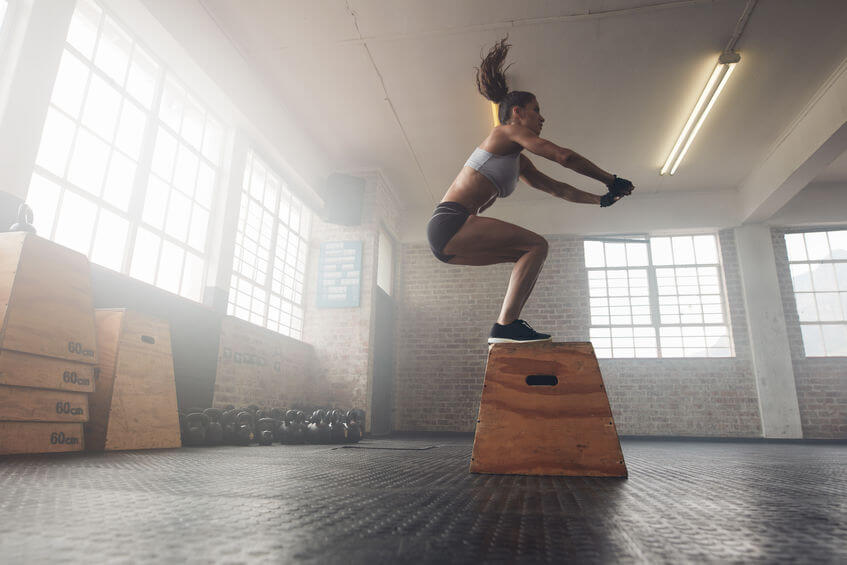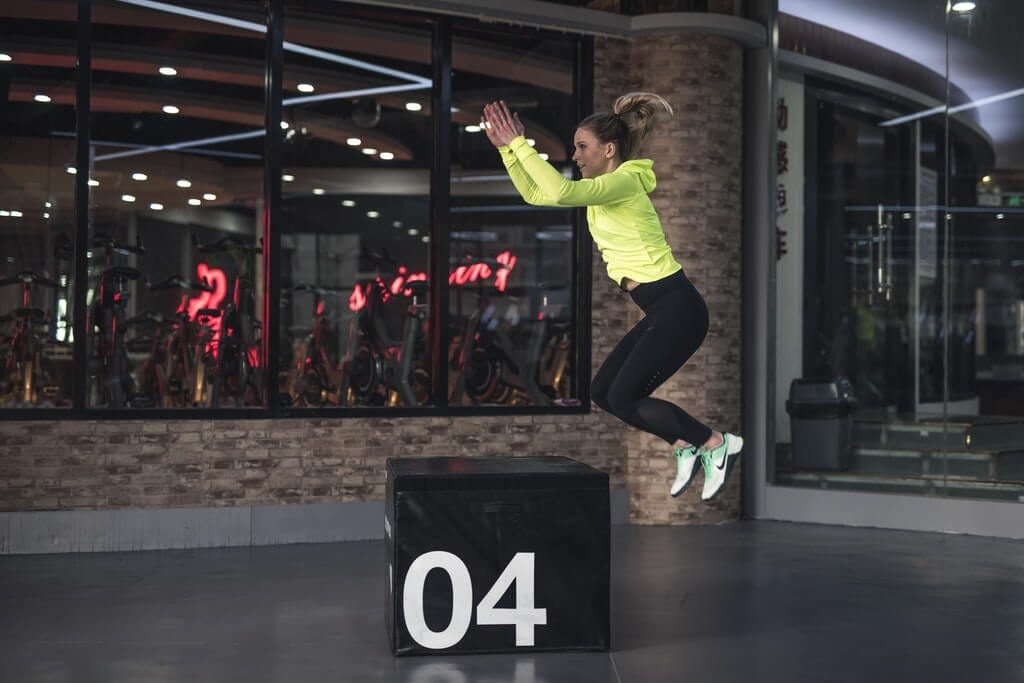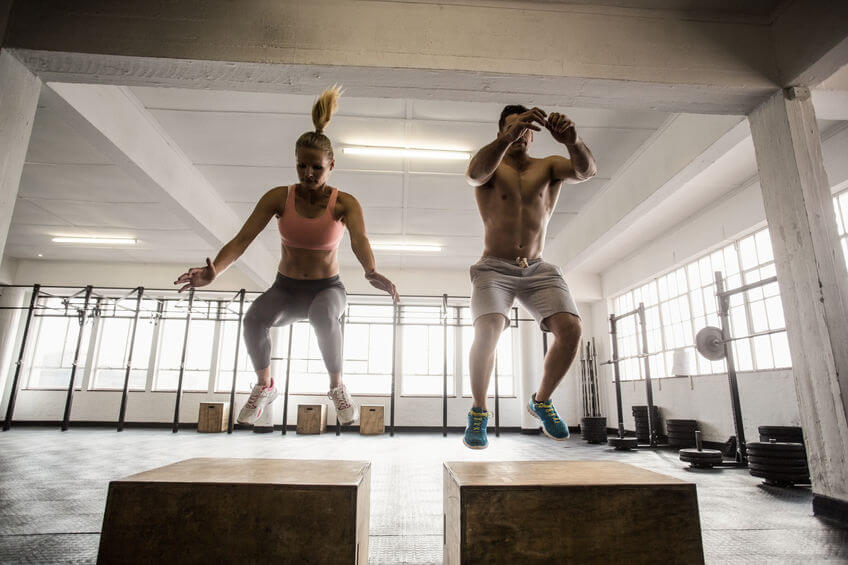8 Best Box Jump Alternatives for Explosive Power
The box jump exercise is one of the best explosive movements out there for building huge leg muscles and developing better balance.
If you’ve ever done them for leg day, I’m sure you’ll agree the burn is intense, but the feeling of growth you get post-workout is well worth it.
A plyometric exercise, the box jump is by no means easy to pull off, but reaps serious physical rewards. For more information on what these are, check out our article on the benefits of box jumps.
So if for whatever reason you can’t do them in your gym or at home, you should definitely be on the lookout for a solid replacement exercise to get similar benefits.
In this article, we’re going to go over some of the best substitutes for the box jump which can be performed either at home, in the gym, or both.
One such alternative which is worthy of mention is the leg press. If you’re interested in buying one for your home gym, make sure to check out our article on the best leg press machines.
That way, you don’t have to spend all afternoon scouring the internet when all you want to do is get your workout for the day done!
Contents
Box Jumps Breakdown
Why Box Jumps?
Before we get into the box jump alternatives, I’d like to take a minute to outline the main muscles worked with the exercise.
After all, if you’re looking for an alternative, you’ll want to make sure you hit the same big muscle groups, right?
As is pretty obvious with any plyometric, or jumping movement, you’ll be primarily building explosive power and fast-twitch muscle fibers with box jumps.
This is important for those times when we need that surge of power (imagining leaping from one rooftop to another like in parkour) or an injection of pace, which is useful for runners and athletes.
Come to think about it, if you participate in any sport that involves the use of the legs – which is pretty much all of them – you’ll get some benefits from performing box jumps, or any of the alternatives we’ll look at later.
Main Muscles Worked
While the biggest muscle groups you will work with the box jump are in the legs (quads, and glutes in particular), you’ll also find this exercise incredibly good for developing core strength and balance.
In order to make sure you land gracefully upon completing the jump up, you’ll need to rely on solid engagement of the core abdominal muscles. That makes this a fun exercise to perform for a stronger core, especially when you’ve had enough of cranking out reps of ab-building exercises like sit-ups and v-sits.
Of course, as I’ve already mentioned, the biggest muscle groups worked with the box jump are undoubtedly in the legs. The slow, controlled descent into a squat will set your glutes on fire, and the explosive jump will do wonders for your quad muscles.
You’ll also be hitting the calf muscles and the hamstrings performing this dynamic movement, so it really is a great exercise for leg day. All the more reason to seek out solid alternatives you can do whenever you need to.
Speaking of which…
Box Jump Alternatives
There are many fantastic box jump alternative exercises out there, which are equally challenging and rewarding, so let’s take a look at some of the best.
- Step-ups
- Squats
- Pistol Squats
- Squat Push-Press
- Treadmill Hill Sprints
- Tuck Jumps
- Broad Jumps
- Depth Jumps
Step-ups
What
A beginner-friendly exercise that can serve as a great stepping stone (sorry) to more advanced box jump alternatives, step-ups are always a great option for any leg day.
Why
Step-ups are a useful exercise to add to rotate into your leg day workout as they can be done relatively easily, and you can modify their difficulty with the addition of weights, or even by wearing a weight vest.
Performing step-ups regularly will help build strength in your legs, while also improving your stamina. This is useful for athletes, and anyone interested in making sure their legs are proportionate with the rest of their body.
Plus, you can do step-ups anywhere. So whether you’re at home, at the office, or in the gym, you’ll be able to knock out some reps and get a nice spike of adrenaline. All you’ll need is a raised platform and you’re good to go.
If you’re serious about step-ups and some of the plyometric exercises in this list, you should check out our article on the best plyometric boxes, so that you can get your hands on the best equipment for your home gym.
How
To perform a step-up, all you’ll need is a bench, or any raised, stable surface which can support your weight. Then, if you want to make the exercise more difficult, you can throw a few dumbbells into the mix.
Start with your feet shoulder-width apart, standing in front of the bench. Step one leg up onto the bench, letting your other leg either dangle or lightly touch the bench, before stepping back down again. It’s really as simple as that.
Squats
What
One of the classics, and one of the best exercises to build up to the more challenging box jump alternatives on this list, the ever-reliable squat is always there for you when you need it.
One of the fundamental movements, squats will serve you whatever your physical goals are.
Why
The squat is not only a super simple movement which has more variations than you can shake a stick at, but also a great lower-body strength-builder.
The bodyweight squat is a great place to start since it’s beginner-friendly, and when you master it, you can optimize your results by incorporating dumbbells or a barbell.
So what muscle groups does the humble squat target?
Well, quads, hamstrings, and calves will benefit the most from this exercise, but you can also expect to develop strong glute muscles from activating them during the descent.
But that’s not even the best thing about squats. The best thing about this classic exercise is that you can perform it anywhere. You don’t even need a bench like you would with step-ups. That should make this one a powerful tool in your workout arsenal.
How
To perform the squat, stand with feet shoulder-width apart, and hands out in front to stabilize.
Then slowly lower your body, pushing your hips back and bending your knees until your butt is level with your knees.
There are also variations which will have you going lower to the ground or making other modifications. One of which we’re going to go over next.
Pistol Squats
What
Pistol squats are not for the squat novice. An incredibly difficult bodyweight exercise, you won’t need to add any weight to this one.
What makes this alternative exercise for box jumps so challenging is the balance it requires, and the monumental leg strength needed to squat on just one leg.
That being said, this exercise – if you can pull it off with good form – has the potential to take the place of box jumps with regards to building posterior leg strength and balance.
Why
As if you needed more convincing that this exercise will make a great addition to your workout routine, the pistol squat is an awesome way to develop unilateral strength, muscular activation, and huge glute muscles.
Unilateral strength refers to the balance of strength between one limb and the other. So for example, if your left leg isn’t as strong as your right, you can give it special attention with the pistol squat and bring it up to speed.
This isolation of individual limbs also leads to greater muscular activation, since you’ll be holding your whole body weight up with just one leg. This can generate new muscle fibers, and lead to better results in the long-run.
Finally, just like with box jumps, the glutes are especially important with the pistol squat. You’ll know what I mean if you’ve ever tried to squat down on one leg.
How
First things first, if you haven’t yet mastered the squat, then don’t attempt the pistol squat just yet. As an advanced exercise, you can cause yourself damage if you attempt it before your body is up to the task.
If you feel like you’re ready to give it a go, here’s how to do it.
Slowly lift one foot off the ground, while bending the knee of your other leg. As you gradually descend as you would with the squat, your raised leg should stay straight and point straight ahead.
Once you get to the point where your raised leg is a few inches off the ground, it’s time to press hard into the floor with your bent leg until you get back to a standing position.
Squat Push-Press
What
As an advanced squat, the squat push-press will allow you to really target the quads and glutes with the extra weight of the dumbells.
You’ll better be able to recreate the explosive push off of the box jump with this exercise as the dumbells will force your glutes to work much harder. Plus you get the extra benefit of working your shoulders too.
Why
If you’re looking to get the benefits of the explosive box jumps without your feet actually leaving the ground, then the squat push-press has you covered.
What’s more, this exercise is a fantastic all-rounder. That means you can incorporate it into leg day, shoulder day, or just Tuesday. The versatility of the exercise makes it hard to miss out on.
As for the muscles targeted, you can expect plenty out of the glutes, quads, core, shoulders and back. Not bad for a box jump alternative.
How
To perform a squat push-press you’ll want to stand with the dumbells just above your shoulders.
Now slowly squat down, driving your hips back, and performing a squat as you normally would. Once you get back to a standing position, drive upwards with your arms sending the dumbells high above your head, then repeat from the beginning.
Treadmill Hill Sprints
What
The wildcard entry, treadmill hill sprints are an unusual replacement for box jumps you might think.
However, treadmill incline or hill sprints are incredibly effective at working the larger muscles in your legs and building crazy stamina and endurance.
While box jumps are a single movement, treadmill incline sprints will have you operating at your maximum over a sustained period of time.
Why
As well as obviously being a fantastic way to improve your cross-country running time, treadmill hill sprints will develop everything from your glutes to your quads.
This exercise is in no way easy, and sustained physical exertion will build some mental fortitude which is invaluable for any form of exercise.
How
The important thing to bear in mind when performing treadmill hill sprints is to work in short intervals, and gradually increase the incline so as not to overexert and potentially risk injury.
Always warm-up before you attempt to do this type of interval training too.
Now set the desired incline on your treadmill, and start with bursts of a few minutes, and work up to 15-20 minutes.
Alternatively, go for a run in the mountains, and mix in a couple of inclined sprints.
Tuck Jumps
What
The first of a trio of jumping exercises we’re going to take a look at, tuck jumps are a great plyometric alternative to the box jump.
Essentially a jumping variation of the squat, the tuck jump is a beginner-friendly, yet surprisingly difficult, way to incorporate plyometrics into your next leg day.
Why
Any exercise which involves jumping is bound to be great for your legs, that’s a given. The tuck jump is one of the simplest jumping exercises, making it a great introduction into the world of plyometrics.
As a box jump alternative, the tuck jump will give you a solid foundation and prove sufficiently effective.
The tuck jump not only works the glutes, but acts as a form of cardio which can help you build some stamina as you work your legs.
How
Stand with your feet roughly shoulder-width apart, and your hands by your sides.
Lower into a half squat, then explode off the ground by pushing off with your feet. As you jump, keep your knees close to your chest, and hold them in if possible.
Broad Jumps
What
The second of the jumping exercises, broad jumps are essentially long jumps, but without the long run up.
Requiring you to generate forward momentum and hurl yourself into the air, broad jumps can do great things for your legs.
Why
This plyometrics exercise is popular among athletes, as it requires you to jump as far as possible, and build strength in your leg muscles to compete with the best.
The main muscles worked in the broad jump are the quads, calves, and hamstrings.
The only difference with this exercise and box jumps is that this one requires you to jump forward whereas box jumps require you to jump upwards. In my eyes that means it’s an almost like-for-like replacement, except this one doesn’t require equipment!
How
To do a broad jump, start with your hands up in the air. Swinging your arms back to generate force, bend your knees and jump forward, propelling yourself further with your arms.
Depth Jumps
What
This last exercise is the most advanced of the jumping exercises we’ve covered in this article.
Why?
Because this one requires speed, explosive power, and great conditioning.
Jumping as soon as you hit the ground, the depth jump is a brutal exercise that will surely test your limits.
Why
Depth jumps provide almost all of the same benefits as box jumps, with the added challenge of needing great reactions and timing.
With this exercise you can expect to hit the quads, hamstrings, calves, and glutes. The plyometric nature of depth jumps will ensure you hypertrophy the leg muscles while also building cardio and endurance.
How
To perform the depth jump, position yourself on a short raised platform, then step off and jump up into the air as soon as your feet touch the ground.
Your arms will help you to generate power if you swing them up the moment you hit the ground.
This exercise is as difficult as it sounds, so don’t be discouraged if you don’t nail it the first time!
I hope you’ve enjoyed this round-up of some of the best box jump alternatives, and that you find one or two you’d like to try out.
If you’re also interested in upper body movements, you might like this article about the best power racks in the market.
If you did like this article, then why not subscribe to our newsletter to find out all about the latest gym equipment and exercises you can use to bulk out your workouts.




